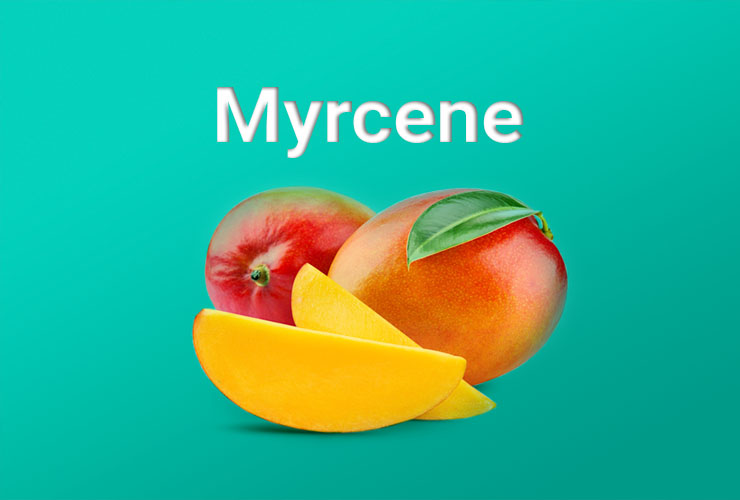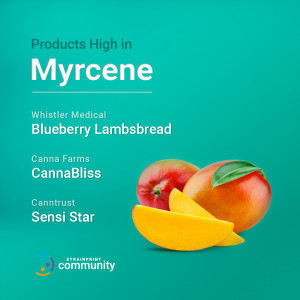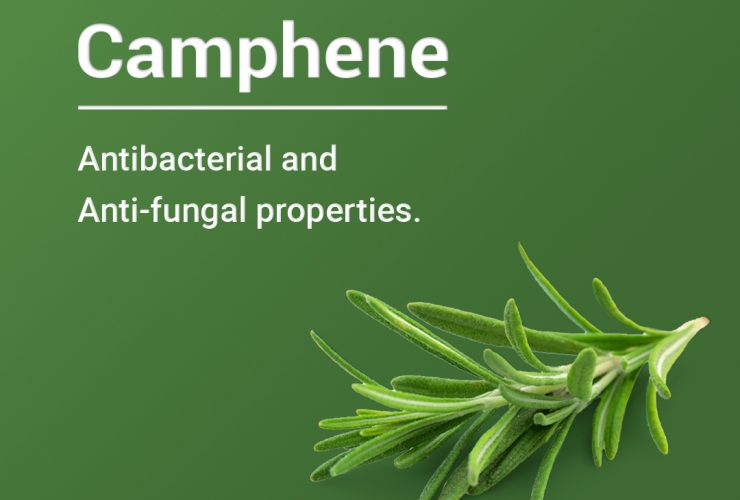Understanding Terpenes: Myrcene

Written by
Welcome to the Strainprint Community Understanding Terpenes Series. This collection of text articles focuses on providing patients with a better understanding of the medical benefits of terpenes, the group of 200 molecules produced by the cannabis herb that have been proven to provide a wide range of efficacies, including analgesic and anti-inflammatory properties of value in the treatment of literally hundreds of diseases and conditions.
Terpenes Defined
Before diving into the details behind myrcene, the most common terpene produced by cannabis (as measured in weight by volume), it behooves readers to develop a solid understanding of terpenes as a category of wellness molecule and how it compares to the other group of healthy chemicals produced by cannabis called cannabinoids (including tetrahydrocannabinol [THC] and cannabidiol [CBD]).
More than 20,000 varieties of terpenes exist throughout nature. The interesting part of the evolution of these odiferous chemicals is that they are shared among different plant species. For example, the terpene linalool—which conveys an aroma of lavender and is present in hundreds of strains of cannabis—is also produced by more than 200 other plants, including lilacs and a variety of herbs and mints.
Terpenes were once thought to deliver nothing more than an enticing aroma to thousands of plants, from cannabis to conifers and lavender to lilacs. From an evolutionary perspective, terpenes help to protect plants from pests and predators with their intense fragrance, acting as a reserve siren song. Within the past couple of decades, however, researchers have learned that terpenes offer medical benefits to all mammals that rival those of their chemical cousins the cannabinoids.
Terpenes constitute approximately 10-20 percent of total pre-smoked resin produced by the nearly microscopic trichome glands of the mature female plants. It is estimated that 10-30 percent of the smoke resulting from the combustion of cannabis flowers is from terpenes.
According to Leafly, “Terpenes play a key role in differentiating the effects of various cannabis strains. Some terpenes promote relaxation and stress-relief, while others promote focus and acuity.”
Loosely speaking, the three primary efficacy benefits of terpenes are their ability to fight pain, the way they reduce systemic inflammation, and their seemingly magical capability to reduce anxiety. Depending on the specific terpene cited, a plethora of other primary and secondary benefits exist, including anti-fungal and anti-bacterial properties.
Entourage Effect + Dr. Ethan Russo
It must be stressed that the theoretical efficacy of an individual terpene, such as myrcene, is confounded by the fact that it is typically consumed in tandem with other terpenes and cannabinoids (including flavonoids, which will be covered in a future Strainprint Community article).
This is especially true for patients who gravitate toward “full spectrum” and “whole plant” products. This issue is addressed by a theory called the entourage effect, the term coined by Dr. Ethan Russo, M.D., a California-based neurologist and one of the pioneers in the field of cannabinoid and terpene research for medical applications.
In 2011, Russo published a research study entitled “Taming THC: Potential Cannabis Synergy and Phytocannabinoid-terpenoid Entourage Effects” in the British Journal of Pharmacology. He and his team studied the terpenes a-pinene, b-caryophyllene, caryophyllene oxide, limonene, linalool, myrcene, nerolidol, and phytol.
In his pinnacle study, Russo explains how cannabinoids and terpenes intermingle in the human body to modify the effects of one another and, in essence, create an overall different, or “greater,” efficacy based on the exact molecules present and, of equal importance, the ratios in which they appear.
Examples of this intricate mechanism revealed by the study include myrcene’s ability to reduce the selectivity of the blood-brain barrier, allowing molecules like THC and CBD to pass this biological filter more easily and in greater quantities. While myrcene illustrates how a terpene can amplify, or boost, a cannabinoid, the terpene pinene has been shown to buffer THC by reducing the cognition and memory impairment that sometimes accompanies the infamous psychoactive molecule.
Russo’s research also demonstrated that a combination of caryophyllene, myrcene, and pinene is helpful for reducing and treating anxiety (more than 100 million Americans suffer from the most common form, social anxiety).
Likewise, the study revealed that a combination of the terpenes limonene and linalool and the cannabinoid cannabigerol (CBG) is helpful in treating MRSA (methicillin-resistant staphylococcus aureus), the most treatment-resistant form of staph infection. CBD, limonene, and linalool have been investigated for their ability to fight acne and treat other skin conditions, including eczema and psoriasis. When combined with THC, the cannabinoid cannabinol (CBN) produces an enhanced sedative effect.
The pioneering Russo study concluded multiple beneficial interactions between myrcene and several major cannabinoids, including THC and CBD.
-
CBD + myrcene: Decreases inflammation, fights cancer, reduces pain.
-
CBG + myrcene: Anti-cancer.
-
THC + myrcene: Analgesic (reduces pain) and muscle relaxant; enhanced sedative and tranquilization benefits.
Understanding Myrcene
Of the hundreds of terpenes that appear in the cannabis genome, none is more common than myrcene (sometimes denoted as β-Myrcene). In terms of aroma, this molecule produces an earthy, spicy, clove fragrance in the strains of cannabis in which it dominates. Because all strains of cannabis feature multiple terpenes, the ratios (relative volumes) in which they appear significantly affect the overall fragrance profile and medicinal efficacy of an individual plant. Myrcene is one of roughly 10 primary, or major, terpenes produced by the cannabis herb.
Myrcene is a constituent element of citronella and menthol and is most common in indica and hybrid strains of the controversial plant. Cannabis strains rich in myrcene include Bubba Kush, Cannatonic, Blueberry Lambsbread by Whistler, Harlequin, Canna Bliss by CannaFarms, Pure Kush, Remedy (which also offers copious amounts of CBD), Sensi Star by Canntrust, Skunk (including Skunk #1 and Skunk XL), Special Kush 1, and White Widow.
A 1997 study conducted in Switzerland found that myrcene may constitute up to 50 percent of the terpene volume of an individual cannabis plant. Of equal significance is the fact that myrcene acts as a precursor to the production of other terpenes, similar to how CBG-A is the universal precursor to other cannabinoids, including THC and CBD.

Medicinal Efficacy
The medicinal efficacy of terpenes and benefits triggered in the mammalian endocannabinoid system (ECS) is surprisingly similar to that of cannabinoids. Myrcene’s major effect is sedative in nature, resulting in relaxed muscles and a reduction of pain. This is of obvious value in a number of conditions involving spasticity, seizure activity, or hyperactivity (including Attention-Deficit/
According to Russo, the available data and findings “support the hypothesis that myrcene is a prominent sedative terpenoid in cannabis, and—combined with THC—may produce the ‘couch-lock’ phenomenon of certain chemotypes that is alternatively decried or appreciated by recreational cannabis consumers.”
Many doctors and researchers recommend myrcene for patients who suffer insomnia, restlessness, and a multitude of forms of anxiety. According to Leafly, “Pair this famously anti-inflammatory terpene with herbal concoctions containing lemongrass or hops for a powerful calm that may put those numbered sheep to rest.”
Myrcene is also a proven anti-depressant and anti-inflammatory. Like another terpene, limonene, myrcene has an effect on the permeability of cell membranes, meaning it acts as a regulator of other terpenes and cannabinoids, enhancing or buffering their effects and potency (similar to how CBD modulates THC).
This unique capability of myrcene allows it to increase the volume of THC molecules that reaches CB1 receptors in the brain and central nervous system, effectively magnifying the potency of this cannabis molecule’s psychoactive effect—while simultaneously amplifying its medicinal efficacy. In this respect, myrcene is an excellent demonstration of the entourage effect.
“It’s the perfect example of the entourage effect in which both terpenes and cannabinoids work together synergistically to produce or enhance a particular therapeutic effect that could not be obtained from a single cannabinoid or terpene,” wrote author Gooey Rabinski in 2015.
In addition to its sedative effect, myrcene delivers anti-carcinogenic, antimicrobial, antioxidant, and antiseptic benefits. It can also suppress muscle spasms, meaning it shows promise in the treatment of neurological conditions such as dystonia, epilepsy, and Parkinson’s. It is theorized that myrcene’s sedative effect, which can be tranquilizing, might be helpful in the treatment of psychosis.
Sativa or Indica?
According to pioneering testing laboratory Steep Hills Labs in Berkeley, California, cannabis that contains more than 0.5 percent myrcene is categorized as indica, conveying a sedative, tranquilizing effect that promotes appetite and sleep. Cannabis samples featuring less than 0.5 percent will result in a sativa strain, characterized by uplifting, energizing, and cerebral effects.
“Less well known is the fact that high β-Myrcene levels in cannabis (usually above 0.5 percent) result in the well known ‘couch lock’ effect of classic indica strains of cannabis; sativa strains normally contain less than 0.5 percent β-Myrcene,” wrote Steep Hill Labs on its website.
Mango Urban Legend
Of the dozens of urban legends surrounding the cannabis herb and the consumption thereof, a few are actually true. Myrcene is produced in high amounts not only in cannabis, but also in basil, bay laurel leaves, hops, lemongrass, mangos, parsley, sweet basil, wild thyme, ylang-ylang, and several other plants. Because mangos produce a significant quantity of myrcene, patients who consume the fruit amplify the potency of any THC they inhale or ingest.
“For most people, the consumption of a fresh mango, 45 minutes before inhaling cannabis, will result in a faster onset of psychoactivity and greater intensity,” wrote Steep Hill Labs.
Those who desire the opposite efficacy due to panic attacks or anxiety from THC, keep the faith! Classic rocker Neil Young recommends black peppers to those who suffer anxiety or panic attacks. “Try black pepper balls if you get paranoid. Just chew two or three pieces,” he told radio host Howard Stern in October 2014 following Stern’s admission of avoiding cannabis due to panic attacks.
The Studies
In addition to the Russo study from 2011 cited above, several other research efforts have revealed the medicinal efficacy of myrcene.
A study published in 2008 in the journal Therapeutics and Clerical Risk Management (and also headed by Dr. Ethan Russo) revealed the analgesic properties of myrcene. The study showed that myrcene displays a pain relieving effect that mimics opium—except without the critical side effect of addiction.
A 2002 research study published in the Journal of Phytotherapy and Phytopharmacology supported the sedative effect of myrcene and its effectiveness for those suffering anxiety, insomnia, and other sleep disorders. “Similar effects were observed for myrcene and limonene at the highest dose (200 mg/kg body wt.), which increased the sleeping time around 2.6 times,” reported the research.
“Our study showed that citral, limonene, and myrcene presented sedative—as well as motor relaxant—effects,” concluded the study’s researchers.


